Visible-Light Generation in Whispering-Gallery-Mode Microspheres via Optical Nonlinearity
| ABG-134082 | Stage master 2 / Ingénieur | 4 mois | 650 euros environ (gratification de stage) |
| 29/10/2025 |
- Physique
Établissement recruteur
Site web :
The Institut FOTON is a research unit of the French National Centre for Scientific Research (CNRS) associated to University of Rennes 1 and the National Institute for Applied Sciences (INSA) of Rennes. FOTON is composed of three research teams: the “Optoelectronics, Heteroepitaxy and Materials” team, the “laser Dynamics, microwave photonics, Polarimetry, terahertz, imaging” team located in Rennes, and the “Photonic Systems” team located in Lannion. The successful candidate will carry out research in Lannion. More information about FOTON can be found at: https://www.institut-foton.eu/.
Description
Context
Compact and highly coherent visible light sources are essential building blocks for metrological applications such as integrated atomic clocks, as well as for quantum technologies including sensing, communication, and computing. The optimization of photonic components relies on the development of integrated narrow-linewidth lasers, optical frequency combs, and efficient cryogen-free single-photon sources. Whispering-gallery-mode (WGM) microresonators have been extensively studied for decades due to their exceptional properties, such as high Q-factors, long photon lifetimes, and small mode volumes. These unique features have enabled the demonstration of various linear, nonlinear, and quantum photonic devices based on WGM resonators.
In recent years, the growing demand for compact coherent sources operating at shorter wavelengths has motivated the research community to explore the potential of WGM resonators in this spectral range. Several recent demonstrations include self-injection-locked lasers1, laser frequency stabilization2, rare-earth-doped microlasers3, and nonlinear optical sources such as Kerr frequency combs4. Atom-based quantum technologies, in particular, require light sources operating at wavelengths resonant with specific atomic transitions. Light generation based on nonlinear optical processes provides a versatile approach to achieve such emission wavelengths for laser5 or photon-pair generation6.
We propose to develop compact WGM microsphere light sources operating in the visible range, based on optical nonlinear processes such as stimulated Brillouin (SBS) and Raman (SRS) scattering, and Kerr effect through four-wave mixing (FWM). Various materials—including polymers, oxide glasses, and fluoride glasses—will be investigated to identify the optimal host matrix that offers a suitable balance between strong optical nonlinearities and a broad transparency window in the visible spectrum. The primary milestone of this project is the demonstration of a narrow-linewidth visible microsphere laser based on stimulated Brillouin scattering. In the next stage, Kerr frequency comb generation in the normal group velocity dispersion (GVD) regime will be explored at visible wavelengths. Upon successful demonstration of Kerr FWM, we will investigate the spontaneous FWM regime to achieve photon-pair generation and characterize its correlation properties aiming towards quantum applications.
The intern will benefit from a dynamic and collaborative research environment. The project is part of ongoing national and international collaborations, in connection with several funded research programs. The intern will work within an active research team including faculty members, postdoctoral researcher, PhD students, and research engineers, and will have access to the laboratory’s experimental facilities. Further information about the team’s research activities can be found on our website (https://www.institut-foton.eu/laser-visible-uv/).
Objectives
In this research internship project, the intern will:
- Learn to fabricate high-Q microspheres resonator using various techniques.
- Learn to fabricate fiber tapers used for light coupling inside high-Q microspheres
- Characterize linear and nonlinear properties of high-Q microresonators using existing optical setups
- Observe and analyze the spectral signatures of nonlinear processes such as SBS, SRS and FWM in a high-Q microsphere at visible wavelengths
- Investigate modal dispersion engineering strategies in microresonators to compensate for material GVD and optimize phase-matching conditions for FWM.
References
1. Savchenkov, A. A. et al. "Application of a self-injection locked cyan laser for Barium ion cooling and spectroscopy." Sci Rep 10, 16494 (2020).
2. Perin, G., et al. "High-Q Whispering-Gallery-Modes Microresonators for Laser Frequency Locking in the Near-Ultraviolet Spectral Range." Journal of Lightwave Technology 42, 5214–5222 (2024).
3. Sureshkumar, A. et al. "Yellow stimulated emission from Dy3+-doped silica glass microspheres." Opt. Express, OE 33, 15802–15813 (2025).
4. Tian, K. et al. "Blue band nonlinear optics and photodarkening in silica microdevices." Photon. Res., PRJ 10, 2073–2080 (2022).
5. Clementi, M. et al. "Ultrabroadband milliwatt-level resonant frequency doubling on a chip." Nat Commun 16, 6164 (2025).
6. Hashimoto, Y. et al. "On-chip photon-pair generation in a silica microtoroidal cavity." Opt. Express 29, 3533 (2021).
Profil
Candidates should hold a Master’s degree in Photonics (or an equivalent field), preferably with demonstrated knowledge and experience in laser physics, nonlinear optics, laser and nonlinear characterization, optical instrumentation, and laser frequency stabilization or locking techniques.
The ideal candidate will have a strong interest in experimental work, complemented by an openness to modelling and simulation activities. Good communication skills in English, both written and spoken, are required
Prise de fonction
Vous avez déjà un compte ?
Nouvel utilisateur ?
Vous souhaitez recevoir nos infolettres ?
Découvrez nos adhérents
 MabDesign
MabDesign  Tecknowmetrix
Tecknowmetrix  Groupe AFNOR - Association française de normalisation
Groupe AFNOR - Association française de normalisation  MabDesign
MabDesign  ADEME
ADEME  TotalEnergies
TotalEnergies  Ifremer
Ifremer  CASDEN
CASDEN  CESI
CESI  ANRT
ANRT  PhDOOC
PhDOOC  ASNR - Autorité de sûreté nucléaire et de radioprotection - Siège
ASNR - Autorité de sûreté nucléaire et de radioprotection - Siège  SUEZ
SUEZ  Laboratoire National de Métrologie et d'Essais - LNE
Laboratoire National de Métrologie et d'Essais - LNE  Généthon
Généthon  Institut Sup'biotech de Paris
Institut Sup'biotech de Paris  Nokia Bell Labs France
Nokia Bell Labs France  Aérocentre, Pôle d'excellence régional
Aérocentre, Pôle d'excellence régional  ONERA - The French Aerospace Lab
ONERA - The French Aerospace Lab

